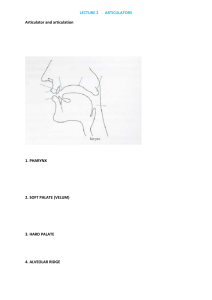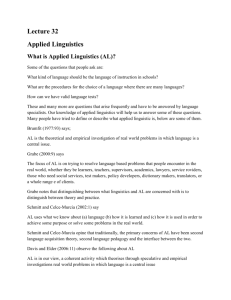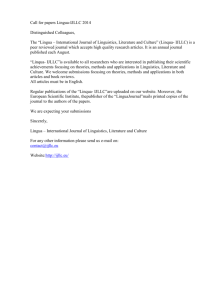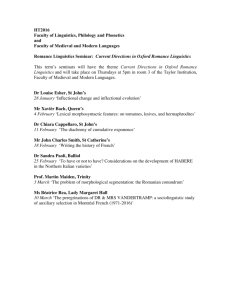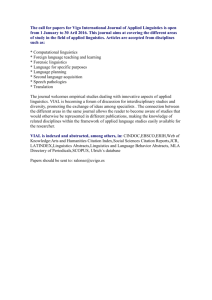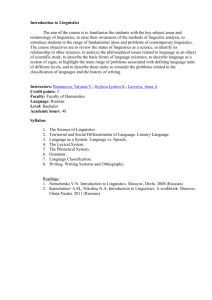Reading
advertisement
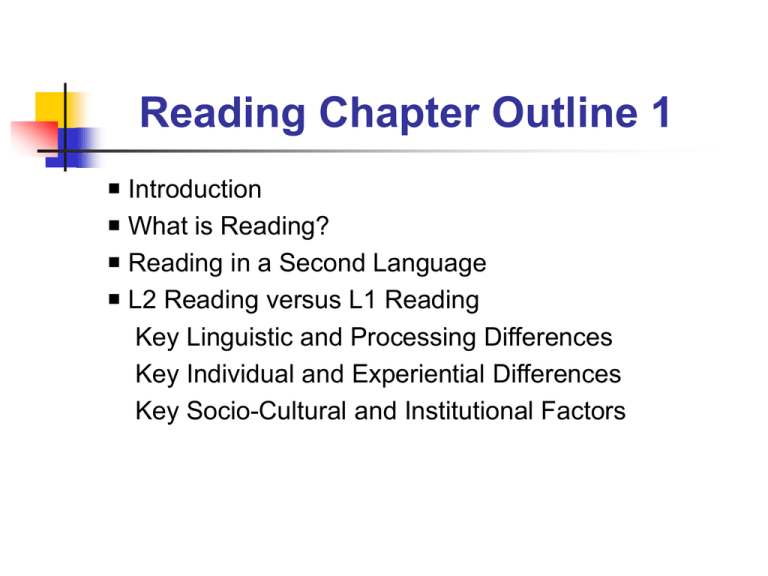
Reading Chapter Outline 1 Introduction What is Reading? Reading in a Second Language L2 Reading versus L1 Reading Key Linguistic and Processing Differences Key Individual and Experiential Differences Key Socio-Cultural and Institutional Factors Reading Chapter Outline 2 Issues in L2 Reading Automaticity and Word Recognition L2 Word Recognition across L1s Vocabulary Reading Rate Language Threshold Role of Background Knowledge in Reading Knowledge of Text Structure & Discourse Cues Meta-cognition and Reading Strategies Extensive Reading / Impact of Exposure to Print Further Issues Implications of L2 Research for Instruction Selected NKFUST Reading-Related Theses Sherry Cheng (2004) Engineers and vocabulary support in reading Ivy Chiu (2005) Engineers and their English textbooks Yvonne Liang (2005) Using dictionaries by engineers Alice Wang (2010) Academic vocabulary of non-English majors Rebecca Hung (2002) Extensive reading Types of Reading Purposes for Reading 1. Scanning 2. Skimming 3. Reading for general understanding 4. Reading to learn 5. Reading to integrate information 6. Reading to evaluate critically 7. Reading for pleasure Carrell, Patricia L. and William Grabe. 2010. Reading. In Norbert Schmitt, editor, An Introduction to Applied Linguistics, 2nd edition, Chapter 13, pp. 215-231. London: Hodder Education, p. 215. Type of Reading and Speed 1. Scanning ≈ 600 wpm 2. Reading for understanding ≈ 250-300 wpm 3. Reading to learn ≈ 200 wpm Carrell, Patricia L. and William Grabe. 2010. Reading. In Norbert Schmitt, editor, An Introduction to Applied Linguistics, 2nd edition, Chapter 13, pp. 215-231. London: Hodder Education, p. 216. L1 Reader Variation Training Age Schooling Motivation Socio-economic level Individual cognition Carrell, Patricia L. and William Grabe. 2010. Reading. In Norbert Schmitt, editor, An Introduction to Applied Linguistics, 2nd edition, Chapter 13, pp. 215-231. London: Hodder Education, p. 216. L1 and L2 Reader Differences 1. They do not have the same language resources as L1 readers 2. They do not share all the social and cultural assumptions and knowledge bases 3. They do not share the background knowledge 4. They have different reasons for studying L2 5. They are working with 2 languages Carrell, Patricia L. and William Grabe. 2010. Reading. In Norbert Schmitt, editor, An Introduction to Applied Linguistics, 2nd edition, Chapter 13, pp. 215-231. London: Hodder Education, p. 216. Major Differences in L1 vs. L2 Reading 1. Key Linguistic and Processing Differences 2. Key Individual and Experiential Differences 3. Key Socio-Cultural and Institutional Factors Carrell, Patricia L. and William Grabe. 2010. Reading. In Norbert Schmitt, editor, An Introduction to Applied Linguistics, 2nd edition, Chapter 13, pp. 215-231. London: Hodder Education, pp. 217-218. Ten Issues in L2 Reading 1 1. Automaticity and Word Recognition 2. L2 Word Recognition Differences across L1s 3. Vocabulary 4. Reading Rate 5. Language Threshold Carrell, Patricia L. and William Grabe. 2010. Reading. In Norbert Schmitt, editor, An Introduction to Applied Linguistics, 2nd edition, Chapter 13, pp. 215-231. London: Hodder Education, pp. 218-228. Ten Issues in L2 Reading 2 6. Role of Background Knowledge in Reading 7. Knowledge of Text Structure and Discourse Cues 8. Meta-Cognition and Reading Strategies Carrell, Patricia L. and William Grabe. 2010. Reading. In Norbert Schmitt, editor, An Introduction to Applied Linguistics, 2nd edition, Chapter 13, pp. 215-231. London: Hodder Education, pp. 218-228. Ten Issues in L2 Reading 3 9. Extensive Reading / Impact of Exposure to Print 10. Further Issues Carrell, Patricia L. and William Grabe. 2010. Reading. In Norbert Schmitt, editor, An Introduction to Applied Linguistics, 2nd edition, Chapter 13, pp. 215-231. London: Hodder Education, pp. 218-228. Implication 1: Automaticity and Word Recognition “Word recognition exercises are probably useful for both older and younger L2 readers, enhancing fluency and raising student awareness of the processing demands of extended independent reading.” Carrell, Patricia L. and William Grabe. 2010. Reading. In Norbert Schmitt, editor, An Introduction to Applied Linguistics, 2nd edition, Chapter 13, pp. 215-231. London: Hodder Education, p. 219. Implication 2: L2 Word Recognition Differences across L1s “Teachers need to be aware that L2 learners coming from an L1 with a different orthographic system may be disadvantaged—particularly at beginning reading levels—not only because they have to learn a new orthographic system, but because they may also need to develop new processing mechanisms more suitable to the L2.” Carrell, Patricia L. and William Grabe. 2010. Reading. In Norbert Schmitt, editor, An Introduction to Applied Linguistics, 2nd edition, Chapter 13, pp. 215-231. London: Hodder Education, p. 220. Vocabulary Issues A. Issues in Vocabulary and L2 Reading Development B. How Much L2 Lexis is Needed? C. The Role of Context in Guessing / Guessability of Word Meaning in L2 Reading D. Dictionary Use and L2 Reading Carrell, Patricia L. and William Grabe. 2010. Reading. In Norbert Schmitt, editor, An Introduction to Applied Linguistics, 2nd edition, Chapter 13, pp. 215-231. London: Hodder Education, pp. 220-222. Issues in Vocabulary and L2 Reading Development Number of words needed Role of context and guessing Role of dictionaries and cognates Strategies Role of extensive or pleasure reading Impact of vocabulary instruction Carrell, Patricia L. and William Grabe. 2010. Reading. In Norbert Schmitt, editor, An Introduction to Applied Linguistics, 2nd edition, Chapter 13, pp. 215-231. London: Hodder Education, p. 220. Implication 3: Vocabulary “In order for L2 learners to read well, they must have an adequately sized vocabulary and must be able to recognize the words in that vocabulary quickly and accurately. Guessing from context and dictionary use can help in acquiring this vocabulary over time, but these skills are not automatic. Rather, they need to be developed and practiced in order to be used effectively in conjunction with reading.” Carrell, Patricia L. and William Grabe. 2010. Reading. In Norbert Schmitt, editor, An Introduction to Applied Linguistics, 2nd edition, Chapter 13, pp. 215-231. London: Hodder Education, p. 222. Implication 4: Reading Rate “Exercises aimed at improving reading rate seem to help L2 learners, in particular those who have already developed their word recognition skills.” Carrell, Patricia L. and William Grabe. 2010. Reading. In Norbert Schmitt, editor, An Introduction to Applied Linguistics, 2nd edition, Chapter 13, pp. 215-231. London: Hodder Education, p. 223. Two Hypotheses about L2 Reading 1. Language Threshold Hypothesis 2. Linguistic Interdependence Hypothesis Carrell, Patricia L. and William Grabe. 2010. Reading. In Norbert Schmitt, editor, An Introduction to Applied Linguistics, 2nd edition, Chapter 13, pp. 215-231. London: Hodder Education, p. 223. Language Threshold Hypothesis “…some minimal threshold of proficiency in the L2 must be attained in order for the reader's first language reading skills to transfer to reading in the second language.” Carrell, Patricia L. and William Grabe. 2010. Reading. In Norbert Schmitt, editor, An Introduction to Applied Linguistics, 2nd edition, Chapter 13, pp. 215-231. London: Hodder Education, p. 223. Linguistic Interdependence Hypothesis “…reading or learning to read is accomplished only once, and that once learners have matured in their ability to read in the first language, the awareness of the reading process transfers to the second language and does not need to be relearned. Thus, reading performance in the second language was claimed to share a common underlying proficiency with reading ability in the first language (Cummins, 1979).” Carrell, Patricia L. and William Grabe. 2010. Reading. In Norbert Schmitt, editor, An Introduction to Applied Linguistics, 2nd edition, Chapter 13, pp. 215-231. London: Hodder Education, p. 223. Implication 5: Language Threshold “It seems that a certain level of L2 proficiency is necessary before L1 reading strategies and skills can be utilized effectively in L2 reading. Therefore, L2 reading development must take place in a learning context that also promotes overall L2 language proficiency, at least for lowerlevel students.” Carrell, Patricia L. and William Grabe. 2010. Reading. In Norbert Schmitt, editor, An Introduction to Applied Linguistics, 2nd edition, Chapter 13, pp. 215-231. London: Hodder Education, p. 224. Implication 6: Role of Background Knowledge in Reading “Appropriate background knowledge about the topic being read helps learners understand the reading better. It is an important element in reading comprehension, but only one of many.” Carrell, Patricia L. and William Grabe. 2010. Reading. In Norbert Schmitt, editor, An Introduction to Applied Linguistics, 2nd edition, Chapter 13, pp. 215-231. London: Hodder Education, p. 225. Implication 7: Knowledge of Text Structure and Discourse Cues “L2 readers can benefit from an understanding of the text structures which organize L2 texts, and can profit from making those structures explicit. Training in awareness of text structure, and specifically how it organizes information in texts, will improve students[’] reading comprehension over time. Carrell, Patricia L. and William Grabe. 2010. Reading. In Norbert Schmitt, editor, An Introduction to Applied Linguistics, 2nd edition, Chapter 13, pp. 215-231. London: Hodder Education, p. 226. Implication 8: Meta-Cognition and Reading Strategies “Better learners actively control their reading and strategy use. Fortunately, it seems that these meta-cognitive skills can be taught, with lower proficiency students gaining the most. Therefore, reading instruction should include some training in these ‘management’ skills.” Carrell, Patricia L. and William Grabe. 2010. Reading. In Norbert Schmitt, editor, An Introduction to Applied Linguistics, 2nd edition, Chapter 13, pp. 215-231. London: Hodder Education, p. 227. Implication 9: Extensive Reading “Extensive reading provides many benefits for fluency, comprehension and vocabulary learning. It should be a component of almost any reading programme.” Carrell, Patricia L. and William Grabe. 2010. Reading. In Norbert Schmitt, editor, An Introduction to Applied Linguistics, 2nd edition, Chapter 13, pp. 215-231. London: Hodder Education, p. 228. POSSIBLE THESIS AREAS Interplay between higher and lower level processes Promoting automaticity in word recognition Motivation in L2 reading Reading and Writing relations Social context factors influencing L2 reading Assessment practices in L2 reading Increasing role of fluency in reading instruction Increasing reading speed Neurolinguistics and reading Reading with new multimedia and computer technologies Teacher training for reading instruction Increasing similarities of L2 reading processes across language as students reach advance levels
